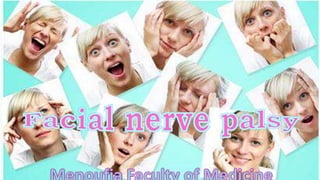
Anatomy and Causes of Facial Palsy
- 2. Content1-Anatomy of the facial nerve 2-Facial palsy: introduction 3- Historical background 4-Types 5-Causes 6-Diagnosis - symptoms Signs or examination investigation 7- Treatment 8-Complications 9-Prognosis
- 3. Akram Mohamed Elsaid hussin Esraa Fathy Aya Gamal Aya Salah eldeen. Aya Elmorshdy Esraa Mohamed Shrook Elfeshawi Rania Roshdy Gehad Mohamed Prof. Dr . Hanaa Nooh Dr. Lobna Taher Dr. Engy Abd El- Azeem Project team Supervisors
- 4. *7th cranial nerve, mixed *Unique –longest course in a bony canal *Nerve of 2nd arch *Nerve of facial expressions *Approx. 7000-10000 fibers introduction CN VII- FACIAL NERVE
- 5. CN VII, beginning and ends
- 6. CN VII, Course and branches
- 7. CN VII, muscles supply
- 8. - Raising the eyebrows (frontalis) . - Closing the eyes (orbicularis oculi) . - Frowning (corrugator) . - Open mouth smiling (zygomaticus) . - Closed mouth smiling (risorius) . - Pouting (orbicularis oris) . - Lifting top lip (levator labii) . - Pulling lower lip down (depressor labii) . - Sticking bottom lip out (mentalis) . - Pulling jaw and corners of mouth gently down (platysma).
- 10. Introduction Bell's palsy is a paralysis or weakness of the muscles on one side of your face (most common cause of unilateral facial paralysis world wide). - Damage to the facial nerve that controls muscles on one side of the face causes that side of your face to droop . - The nerve damage may also affect your sense of taste and how you make tears and saliva. - This condition comes on suddenly, often overnight, and usually gets better on its own within a few weeks.
- 11. Historical background The history of facial distortion as described by Greek, Roman, and Persian physicians & culminating in Razi's description in al-Hawi). Although allusions to facial nerve disorders can be traced to Hippocrates, the first comprehensive description was by the 9th-century Persian physician Razi. In 1821, Sir Charles Bell and its association described the anatomy of the facial nerve with the unilateral facial palsy. however, described by earlier physicians as; Sydenham, Stalpart van der Wiel, Douglas, Friedreich, and Thomassen à Thuessink.
- 12. Types UMNL LMNL
- 13. Causes -Viral infections such as Bell’s palsy and Ramsay Hunt syndrome. - Surgical causes: for example during removal of acoustic neuroma or facial nerve tumour, or when operating on the parotid gland. - Bacterial causes such as Lyme disease or following a middle ear infection.
- 17. EXAMINATION To determine the extent of the weakness in your facial muscles. The doctor can do a variety of tests to make a Bell’s palsy diagnosis
- 18. INVESTIGATIONS an MRI or CT scan to check the nerves in your face. blood tests to check for the presence of a bacterial or viral infection.
- 19. treatment Medical Physical Surgical others
- 20. Treatment with corticosteroid medicines (such as prednisone) Sometimes antiviral medicines (such as acyclovir Most people who have Bell's palsy recover completely, without treatment, in 1 to 2 months Medical
- 21. Manual Massage Different massage techniques performed on the muscles of the face to regain facial animation and balance. Neuromuscular Retraining (NMR) Exercises to retrain your body to use its muscles more effectively and efficiently. Physical
- 22. Primary nerve repair provides the best return of facial nerve function. However, the primary repair should be tension free. Cable nerve grafts utilized when a tension-free primary nerve repair is not possible. Common donor nerve grafts include: great auricular nerve, sural nerve, and medial and lateral antebrachial cutaneous nerves. Surgical
- 23. If you have no feeling and little saliva on one side of your tongue, food may get stuck there, leading to gum disease or tooth decay. Brush and floss your teeth often and well to help prevent these problems. To prevent swallowing problems, eat slowly and chew your food well. Eating soft, smooth foods, such as yogurt, may also help. MOUTH CARE EYE CARE protect the eye and keep it moist: •Use finger to close and open your eyelid throughout the day. •artificial tears. •eye patch while you sleep, •glasses or goggles the rest of the time. others
- 24. • Most people fully recover from Bell's palsy within nine months. However, long- term complications of Bell’s palsy are more likely to occur if: • you have been affected by a complete palsy, resulting in no movement at all (paralysis) on one side of your face • you are over 60 years of age • you had severe pain when you first experienced symptoms • you have high blood pressure • you have diabetes • you are pregnant • your facial nerve is badly damaged • recovery doesn't begin until two months have passed • there are no signs of recovery after four months complications
- 25. Prognosis
- 26. Refrences 1 - Gupta, Sachin; Francine Mends; Mari Hagiwara; Girish Fatterpekar; Pamela C. Roehm (2013). "Imaging the Facial Nerve: A Contemporary Review". Radiology Research and Practice. 2013: –248039. doi:10.1155/2013/248039. ISSN 2090-1941. Retrieved 2015-02-07. 2 - PhD, Richard S. Snell MD (2011). Clinical Anatomy by Regions (Ninth ed.). Philadelphia, Pa.; London: LWW. ISBN 9781451110326. 3 - Singh, Vishram. Textbook of Clinical Neuroanatomy (2nd ed.). p. 104. 4 - Dudek, Ronald W. (2014). BRS Embryology (Sixth ed.). LWW. ISBN 9781451190380. 5 - Moore, Keith L.; T. V. N. Persaud; Mark G. Torchia (2011). The Developing Human: Clinically Oriented Embryology with Student Consult Online Access, 9th Edition (9th ed.). Philadelphia, PA: Saunders. ISBN 9781437720020. 6 - Kliniska Färdigheter: Informationsutbytet Mellan Patient Och Läkare, LINDGREN, STEFAN, ISBN 91-44-37271-X
